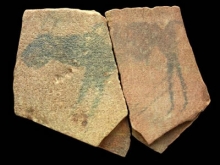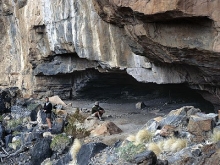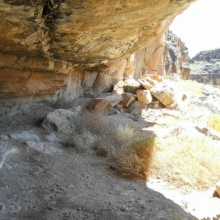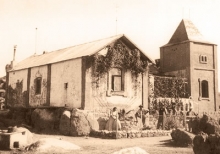History and Culture
Archaeological heritage
Sites on the Orange River indicate that humans have used the area for at least 1 million years, with tools of 800,000 years being found. Within the Fish River Canyon a large number of sites have been identified, ranging from colonial era to Pleistocene and earlier but they are largely unstudied.
The most well-known archaeological site is the Apollo 11 Rock Shelter in the Huns Mountains in the northern part of the /Ai-/Ais Hot Springs Game Park. This internationally important site was discovered in 1969. The mobile stone slab paintings excavated here have been dated by radiocarbon dating at 27,000 years old making them amongst the oldest known artwork from Africa. The paintings were painted in charcoal, ocher, and white and depict a range of subjects from simple geometric patterns to bees. Rock engravings depicting animals and geometric patterns were also found near the cave. A series of distinct cultural layers were found, indicating that the cave may have been used by different people for more than 100,000 years.
There are several other sites in this vicinity which have engravings and rock paintings. At least 6 Early Stone Age and 3 Middle Stone Age sites have been identified in the canyon as well as several more recent pre-colonial herder sites.
Surveys at the confluence of the Boom Dabimub on the Orange River have located numerous archaeological sites, predominantly of nomadic pastoral encampments from with the last 2000 years. Early pastoralists tended to be nomadic, grazing sheep, goats and cattle over wide areas of shrubland in response to local rainfall. In the last century, livestock production in the south of Namibia has become more sedentary, focused on sheep and goat production around developed water points.
Colonial heritage
There are a number of colonial buildings and sites within the landscape which can be linked directly with important historic events. Witputs in the Canyon Nature Park contains the ruins of a farmhouse which belonged to Reinier Coetzee, the last person to see Adolf Lüderitz alive. Nearby is the location of a police station from where the area up to the Sendelingsdrift border gate was patrolled. There are also World War I trenches and ruins associated with Manie Maritz, the rebel Boer General who joined the German forces in 1914.
Cultural heritage
The landscape reflects aspects of Nama and San culture and language with many geological and natural features, such as /Ai-/Ais, having Nama or San names. Indigenous knowledge such as the traditional uses of plants, and their indigenous names, reflect the traditions of the Khoe and the San. There has been a history of terrible oppression, genocide and marginalisation in the south of Namibia during the colonial era, where the colonial authorities waged a war of extermination against Nama and other groups.
Relevant literature
-
A Brief Heritage Survey of the /Ai-/Ais Richtersveld Transfrontier Park (ARTP)
A Brief Heritage Survey of the /Ai-/Ais Richtersveld Transfrontier Park (ARTP), July 2013
The /Ai-/Ais Richtersveld Transfrontier Park, hereafter referred to as ARTP, has significant geological and palaeontological, natural, archaeological and architectural heritage. The area also has a substantial and complex historical and cultural heritage. Fully mobilised, this heritage would add substantial value to tourism in the ARTP and assist local people with the development and protection of their culture. The tourism potential of the ARTP as a whole could be expanded by fully unlocking the tourism potential of all heritage categories in the ARTP. This is the result of an initial survey of heritage resources in the ARTP. The survey focus on archaeological, paleontological, natural and geological heritage as well as places and buildings of historical significance» Download -
Historic distribution of large mammals in the Greater Fish River Canyon Complex, southern Namibia, and recommendations for re-introductions
Brown, C.J. 2006. Historic distribution of large mammals in the Greater Fish River Canyon Complex, southern Namibia, and recommendations for re-introductions.
This report looks at the historic distribution of larger mammals in the Greater Fish River Canyon Complex of southern Namibia. Based on this information, as well as the present distribution of mammals and the present environmental conditions within and surrounding the Complex, it makes recommendations for the re-introduction and enhancement of large mammal populations.» Download







